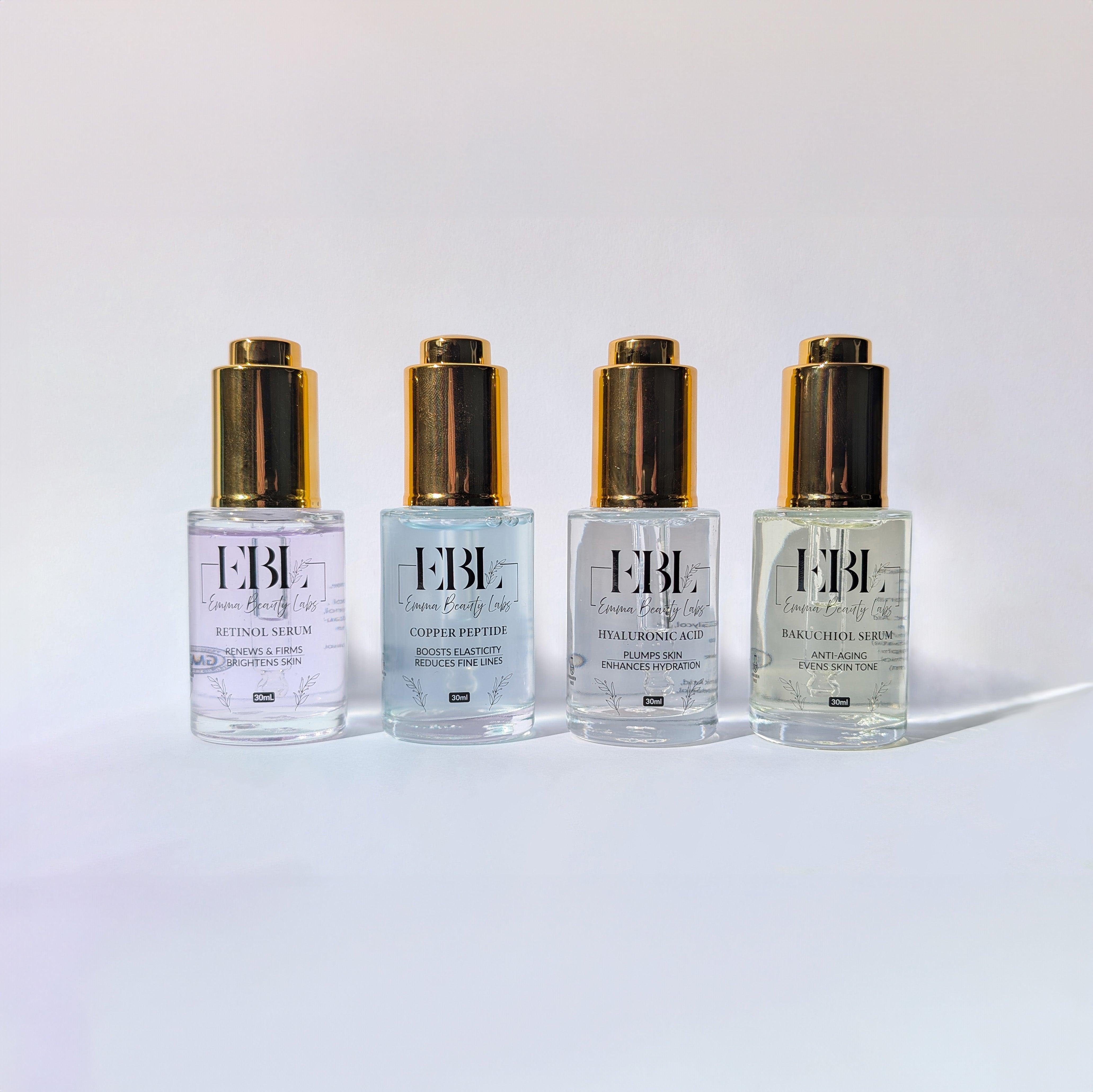Understanding How Perimenopause Affects Skin and Finding the Best Skincare for Perimenopausal Women
One day, I was enjoying the firm, elastic skin of my 30s, and the next, I found myself facing sagging around my jawline and the start of crow’s feet. My skin suddenly seemed to be on its own journey, and I wasn’t quite prepared. And if that wasn't enough, I also had a few surprising “throwback” pimples to remind me of the early 2000s!
It’s been a learning curve, experimenting with skincare that meets these new needs without overwhelming my skin. Retinol and copper peptides became staples, but I realized that some of my old habits had to go. Morning cleansing? Gone. I discovered that just rinsing with warm water was less drying, creating a smooth base for my serum and moisturizer. I also cut back on exfoliating every week and learned the art of double cleansing in the evening by adding an oil cleanser—thank you, TikTok! These little changes have made all the difference in keeping my skin feeling hydrated and resilient.
If you’re experiencing similar changes, know you’re not alone. Here’s a breakdown of the skin changes we encounter during perimenopause, and some expert-approved steps you can take to keep your skin healthy and balanced.
Why does perimenopause affect my skin?

Perimenopause marks the transition towards menopause, often starting in our 40s and lasting a few years. During this time, estrogen levels fluctuate, impacting our skin in unexpected ways. Estrogen is key to retaining moisture, ceramides, and natural oils, which help keep our skin smooth, plump, and hydrated. As estrogen drops, skin can become drier, thinner, and even prone to breakouts — a combination that can feel confusing!
As skin becomes thinner and loses collagen and elasticity, wrinkles and sagging appear more prominent. Research shows that 30% of skin collagen may be lost within the first five years of menopause, which contributes significantly to these changes and is why deterioration can feel so rapid!
According to the Australasian College of Dematologists, some skin changes you may notice include:
- Acne or rosacea
- Dark “age” spots
- Decreased wound healing and barrier function
- Dry skin
- Itching, dermatitis
- Sagging skin and wrinkles
- Loss of plumpness
- Skin thinning as there is less collagen and elastin being produced.
Several of these changes are due to lifetime sun exposure causing damage to the skin.
Let's understand whats happening in a bit more detail:
1. Dryness and Dullness
Without sufficient estrogen, our skin struggles to retain moisture, often leading to that tight, dry feeling. Our natural ceramides and hyaluronic acid — those essential moisture-locking elements — decrease, leaving our skin needing a bit more help to stay hydrated.
2. Redness and Sensitivity
You might notice sudden redness, flushing, or sensitivity, especially if rosacea is in the mix. The blood vessels in our skin become more reactive, and those quick fixes we used to rely on may no longer be effective.
3. Breakouts and Adult Acne
Just when we thought acne was a thing of the past, perimenopausal skin may throw us an unwelcome surprise. As our hormone levels change, we’re more susceptible to breakouts, particularly around the chin and jawline. Many women, including myself, experience these “stubborn” spots that seem to linger indefinitely. This is because thinner skin also means wounds and blemishes take longer to heal, and new spots can seem more stubborn.
Personal Tip: When I do get a spot, I switch to Bakuchiol serum which has anti-blemish abilites thanks to its antioxidant, anti-inflammatory, and anti-bacterial properties.
4. Loss of Firmness and Elasticity
During perimenopause, collagen production declines, which can lead to thinner, less elastic skin. This change can mean more visible fine lines and sagging, along with slower wound healing and increased vulnerability to environmental factors.
How to Manage Perimenopausal Skin Changes
1. Moisturize and Replenish
Choose a moisturizer that helps to lock in moisture without being heavy. Look for ingredients like ceramides and peptides, which help to strengthen the skin barrier and boost hydration levels without causing irritation. A lighter moisturizer can be perfect during the day, while a richer one at night can provide extra nourishment.
Personal Tip: I’ve found that applying Hyaluronic Acid immediately after a shower while my skin is still slightly damp locks in extra moisture—making my skin feel soft and hydrated all day.
2. Be Gentle with Cleansing
Steer clear of foaming cleansers or anything that bubbles or lathers, as they can strip the skin of its natural oils. Instead, opt for a gentle, non-foaming cleanser that cleans without drying, keeping your skin’s natural barrier intact.
3. Consider Targeted Treatments for Breakouts
For spot-prone areas, a gentle approach works best. Instead of treating the entire face, focus on the areas with breakouts. A mild, non-comedogenic product with salicylic acid can help exfoliate and keep pores clear. If your skin is particularly sensitive, products with niacinamide or a low-strength retinol may work wonders without causing irritation.
Personal Tip: When my skin feels sensitive, I skip retinol and opt for hydrating serums with peptides instead, which calms my skin and prevents dryness.
4. Protect Your Skin from the Sun

UV protection is essential, especially as our skin becomes more vulnerable. Choose a broad-spectrum SPF 30 or higher and apply it every morning. If you’re out in the sun, reapply every couple of hours and consider a wide-brimmed hat for added protection. Consistent SPF use not only prevents further damage but also preserves the skin's elasticity and collagen levels.
5. Boost Your Collagen with Skincare
Anti-aging ingredients like retinoids, peptides and vitamin C are effective in preserving skin’s collagen and boosting radiance. Just remember, perimenopausal skin is more sensitive, so stronger retinoids may need to be adjusted. Choosing gentler, skin-friendly formulations that support collagen without irritation can be a great compromise. Try 0.3% retinol or a gentle retinol alternative like bakuchiol. Patience is key, as it may take a few months to see noticeable improvements with these ingredients.
Listen to Your Skin and Adapt Your Routine
In perimenopause, it’s essential to tune in to what your skin needs on any given day. If your skin feels sensitive or irritated, take a step back and simplify. Our skin is undergoing changes, and there’s no need to “fight” it — just support it with nourishing, gentle products. Embrace your skin’s needs as they evolve, and don’t stress over using multiple products. A routine of just a few reliable items can be effective.
Navigating Skin Changes Together
Perimenopause can feel like a rollercoaster, but you’re not alone. Our skin, like the rest of our bodies, is going through a season of change, and with a little extra care, we can maintain a fresh, healthy glow. So, let’s be kind to our skin, lean on products that nurture and protect it, and embrace this chapter with grace.








